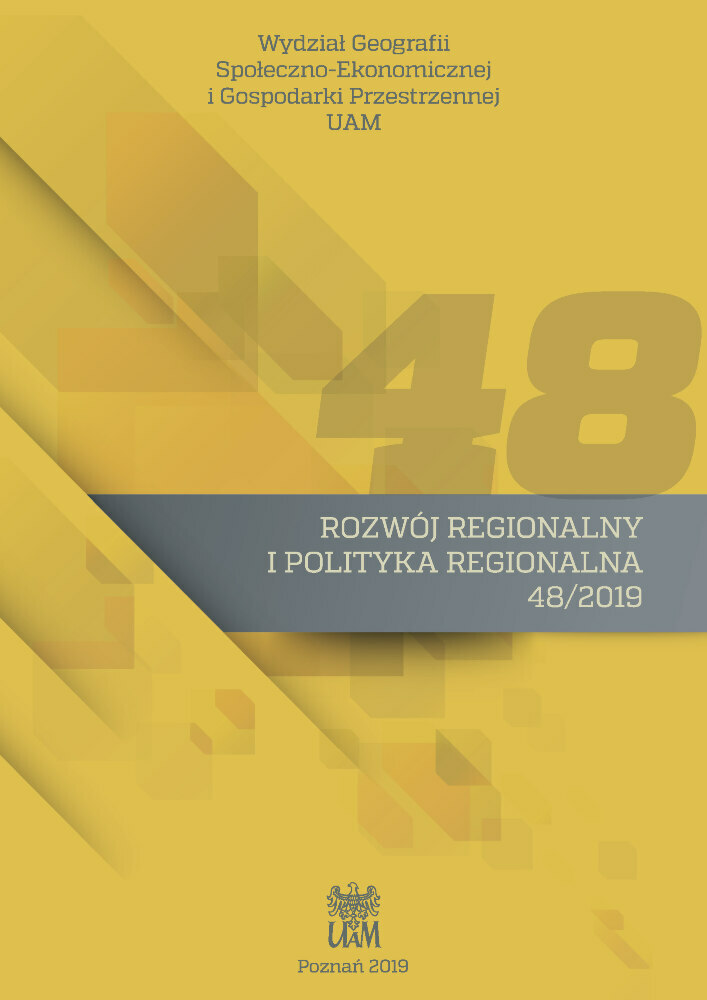Abstract
The main purpose of the work is to describe and evaluate the implementation of the slow city concept in small cities, located in the zones of influence of large cities. The research subjects are two cities, Murowana Goślina in the Poznań agglomeration (Poland) and Schneverdingen in the metropolitan area of Hamburg (Germany). The local resources of both cities were analyzed, such as: values of the natural environment, cultural heritage, economic functions, social and tourist infrastructure as well as urban policies related to obtaining a certificate of membership in an international organization such as the Cittaslow network. A number of similarities have been found for the abovementioned resources, while using them differently as factors for local development. Based on the results of social research (interviews with representatives of local authorities and a survey among residents), it was shown that in the process of implementing the slow city idea, elements of social capital, including the knowledge and determination of local authorities, as well as the awareness and commitment of residents play a key role.
References
Ball S. 2015. Slow Cities. [W:] W. Davies (red.), Theme Cities: Solutions for Urban Problems. GeoJournal Library, 112: 563–585.
Camagni R. 2009. Territorial capital and regional development. [W:] R. Capello, P. Nijkamp (red.), Handbook of Regional Growth and Development Theories, Edward Elgar, Cheltenham: 118–132.
Chojnicki Z. 1999. Podstawy metodologiczne i teoretyczne geografii. Bogucki Wydawnictwo Naukowe, Poznań.
Churski P., Kołsut B. 2017. Potencjał rozwojowy gminy Powidz w okresie postępującej endogenizacji procesów rozwoju. Rozwój Regionalny i Polityka Regionalna, 40: 35–52.
Creswell J.W. 2013. Projektowanie badań naukowych. Metody jakościowe, ilościowe i mieszane. Wydawnictwo Uniwersytetu Jagiellońskiego, Kraków.
Danielewicz J.,Turała M. 2016. Territorial capital as a determinant of development processes in functional areas. Acta Universitatis Lodziensis. Folia Oeconomica, 319(2), European Planning Studies, 23(7): 55–68.
Davies W. (red.) 2015. Theme Cities: Solutions for Urban Problems. GeoJournal Library, 112: 559.
Farelnik E. 2018. Idea slow jako wyznacznik działań rewitalizacyjnych podejmowanych na obszarach miejskich. Metropolitan, 1(9): 18–27.
Farelnik E., Stanowicka A., 2016, Smart City, Slow City and Smart Slow City as Development Models of Modern Cities. Olsztyn Economic Journal, 11(4): 359–370.
Fukuyama F. 1997. Zaufanie. Kapitał społeczny a droga do dobrobytu. PWN, Warszawa–Wrocław.
Garreau J. 1991. Edge City: Life on the New Frontier. Doubleday, New York.
Gruszecka-Tieśluk A. 2013. Sieć Cittaslow – strategią rozwoju małych miast w Polsce? Studia Ekonomiczne, 144(2): 383–393.
Grzelak-Kostulska E., Hołowiecka B., Kwiatkowski G. 2011. Cittàslow International Network: An Example of a Globalization Idea? [W:] P. Mácha, T. Drobík (red.), The Scale of Globalization Think Globally, Act Locally. Change Individually in the 21st Century. University of Ostrava, Ostrava, s. 186–192.
Heffner K., Halama A. (red.) 2012. Ewolucja funkcji małych miast w Polsce. Studia Ekonomiczne. Zeszyty Naukowe Wydziałowe Uniwersytetu Ekonomicznego w Katowicach.
Heffner K., Marszał T. (red.) 2006. Uwarunkowania rozwoju małych miast. Biuletyn KPZK PAN, 226.
Heffner K., Marszał T. (red.) 2007. Małe miasta w obszarach metropolitalnych. Biuletyn KPZK PAN, 232.
Honore C. 2011. Pochwała powolności. Drzewo Babel. Warszawa.
Konecka-Szydłowska B. 2017. Zróżnicowanie polskiej sieci miast Cittaslow w aspekcie społeczno-gospodarczym. [W:] E. Strzelecka (red.), Alternatywne modele rozwoju miast. Sieć miast Cittaslow. Wydawnictwo Politechniki Łódzkiej, Łódź, s. 61–73.
Korcelli P. 2018. System osadniczy Polski – kierunki przemian. [W:] P. Churski (red.), Teoretyczne i aplikacyjne wyzwania współczesnej geografii społeczno-ekonomicznej. Studia KPZK PAN, 183: 263–271.
Kwiatek-Sołtys A., Mainet H. 2015. Cittaslow, a Qualitative Approach to Small Towns’ Local Development. [W:] M. Soja, A. Zborowski (red.), Miasto w badaniach geografów. T. 2. Uniwersytet Jagielloński, Instytut Geografii i i Gospodarki Przestrzennej, Kraków, s. 39–45.
Leven C.L. 1978. Growth and nongrowth in metropolitan areas and the emergence of polycentric metropolitan form. Papers of the Regional Science Association, 41: 101–112.
Mayer H., Knox L.P. 2006. Slow Cities: Sustainable Places in a Fast World. Journal of Urban Affairs, 28(4): 321–334.
Mazur-Belzyt K. 2014. Współczesne podstawy rozwoju małych miast na przykładzie sieci miast Cittàslow. Problemy Rozwoju Miast. Kwartalnik Naukowy Instytutu Rozwoju Miast, 3: 39–45.
Miele M. 2008. CittàSlow: Producing slowness against the fast life. Space & Polity, 12(1): 135–156.
Phelps N., Wood A., MacLeod G., Jones N. 2011. The New Post-suburban Politics? Urban Studies, 48(12): 2591–2610.
Radstrom S. 2011. A Place-Sustaining Framework for Local Urban Identity: An Introduction and History of Cittaslow. Italian Journal of Planning Practice, 1(44): 90–113.
Rink D., Haase A. (red.) 2018. Handbuch Stadtkonzepte: Analysen, Diagnosen, Kritiken und Visionen. Verlag Barbara Budrich, Opladen, Toronto.
Sept A. 2018. Zur Fallauswahl im qualitativen Stadtvergleich: eine Heuristik am Beispiel des Städtenetzwerks Cittaslow. Europa Regional, 1: 2–14.
Solarek K. 2011.Współczesne koncepcje rozwoju miasta. Kwartalnik Architektury i Urbanistyki, 56, 4: 51–71.
Szarek-Iwaniuk P. 2019. Potencjały i bariery rozwoju małych i średnich miast na przykładzie polskiej krajowej sieci miast Cittaslow. Zarządzanie Publiczne, 1(45): 1–18.
Szelągowska A. 2014. Slow city jako innowacyjna koncepcja rozwoju miast. [W:] M. Bryx (red.), Innowacje w zarządzaniu miastami w Polsce. Szkoła Główna Handlowa w Warszawie, s. 215–221.
Tanti M. 2011, Towards a Paradigm of Slow (http://sydney.edu.au/ education_social_work/coco/ events/research_fest/2011/1PCMiriam.pdf).
Teaford J.C. 2011. Suburbia and Post-suburbia: A Brief History. [W:] N.A. Phelps, F. Wu (red.), International Perspectives on Suburbanization. Palgrave Macmillan, London, s. 15–34.
Tóth B.I. 2015. Territorial Capital: Theory, Empirics and Critical Remarks. European Planning Studies, 23(7): 1–18.
Zaucha J., Brodzicki T., Ciołek D., Komornicki T., Mogiła Z., Szlachta J., Zaleski J. 2015. Terytorialny wymiar wzrostu i rozwoju. Difin, Warszawa.
Zawadzka A. 2017. Potencjalne implikacje społeczno-ekonomiczne akcesji do sieci Cittàslow w erze przyspieszenia. Biuletyn KPZK PAN, 266: 125–141.
License
Copyright
© 2019 WGSEiGP, Uniwersytet im. Adama Mickiewicza w Poznaniu
OPEN ACCESS
